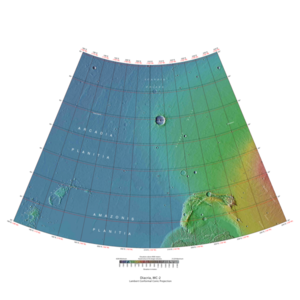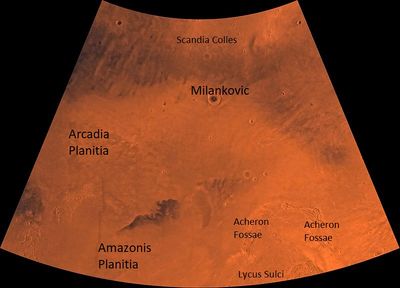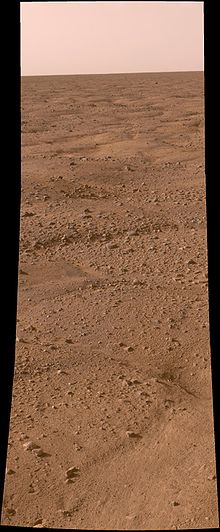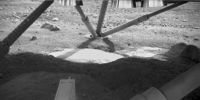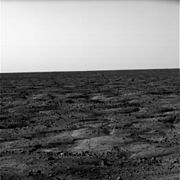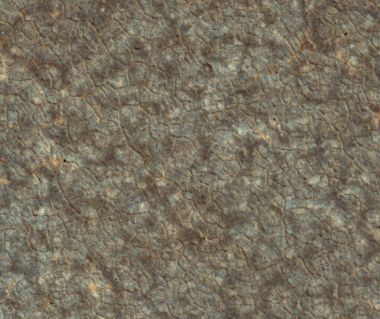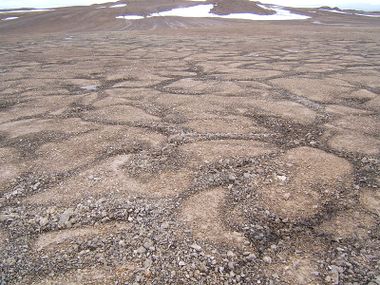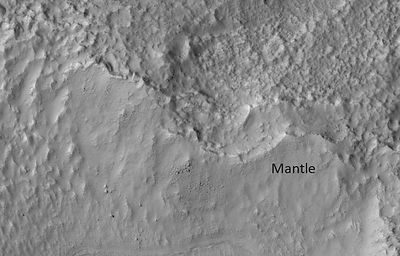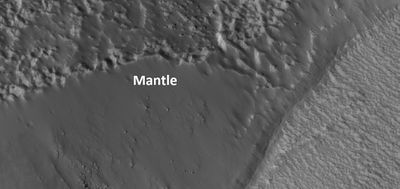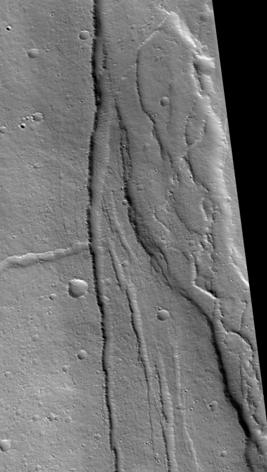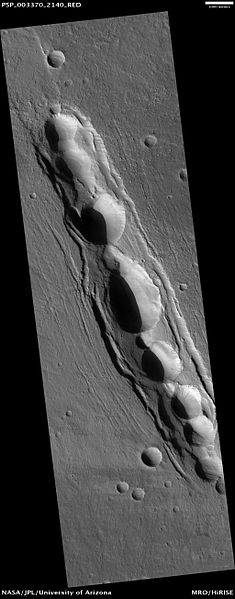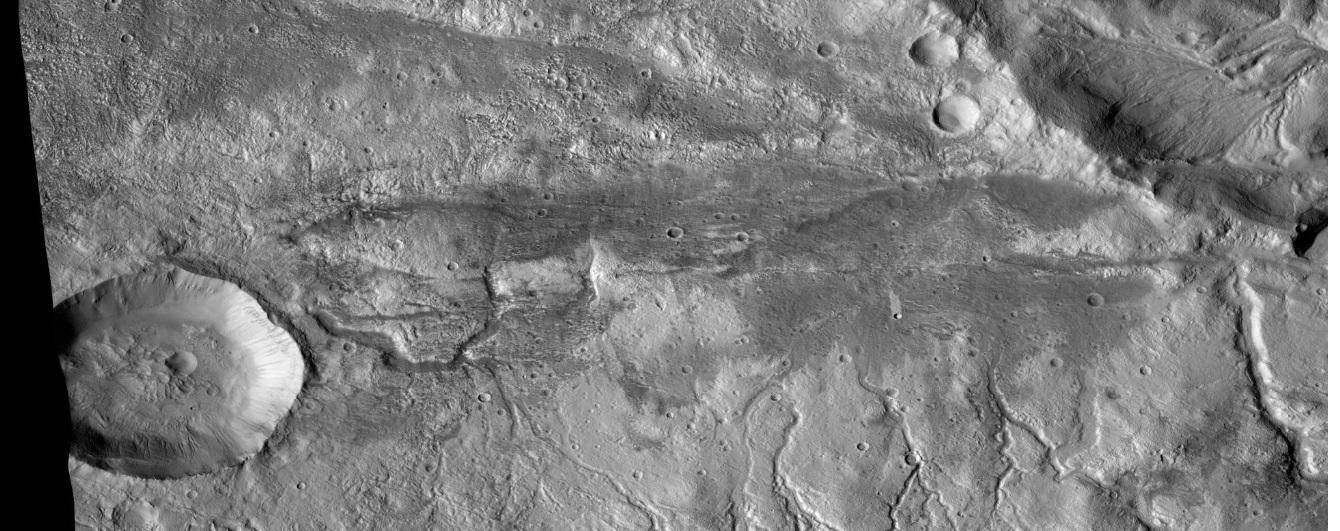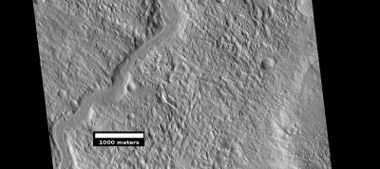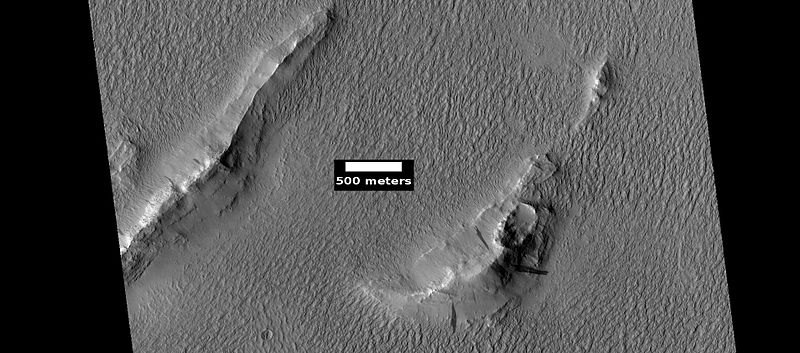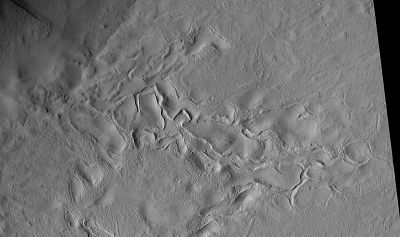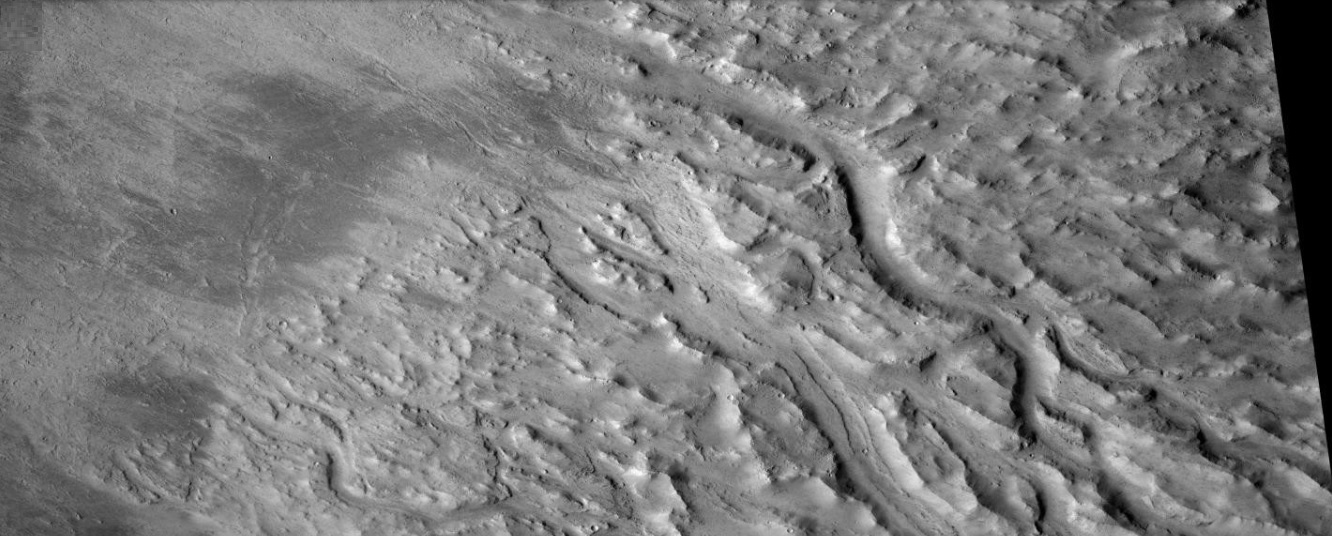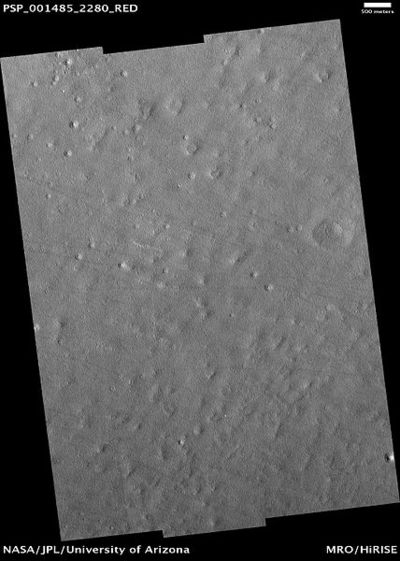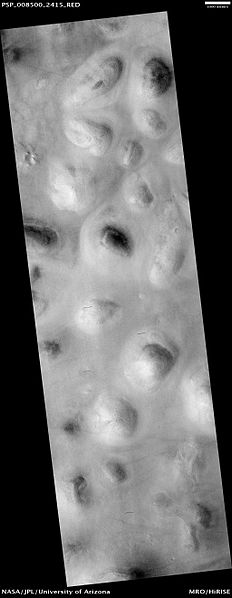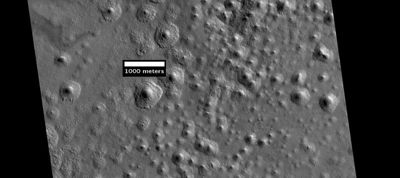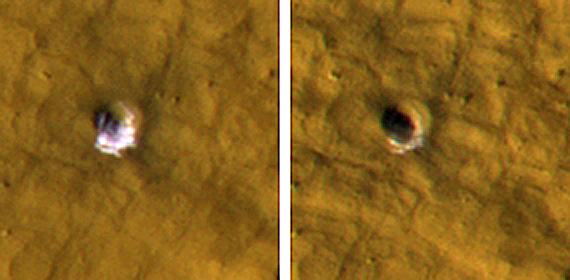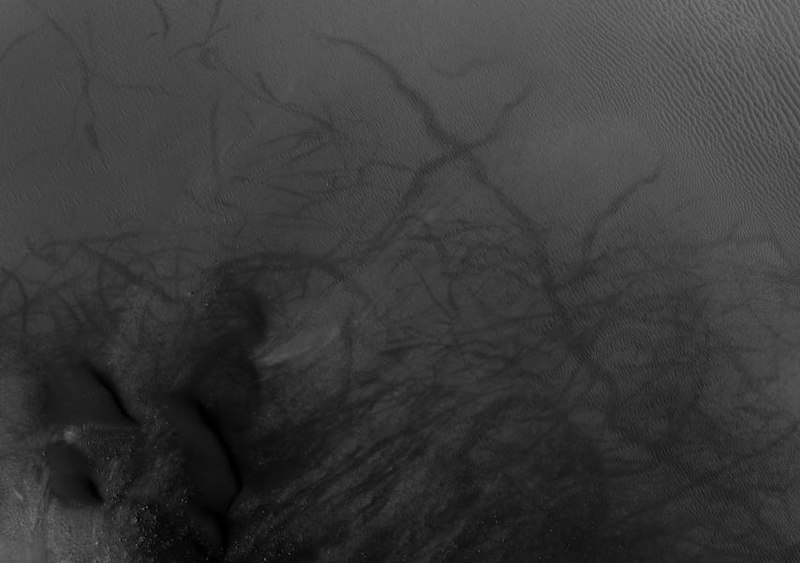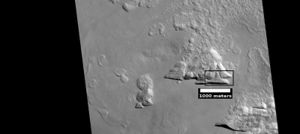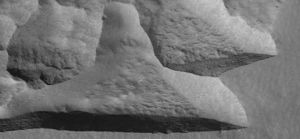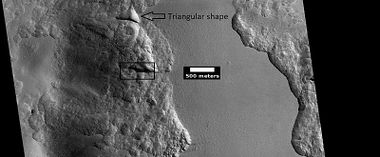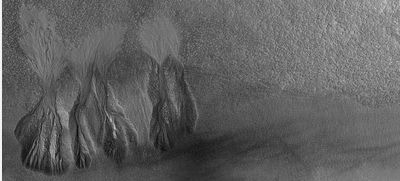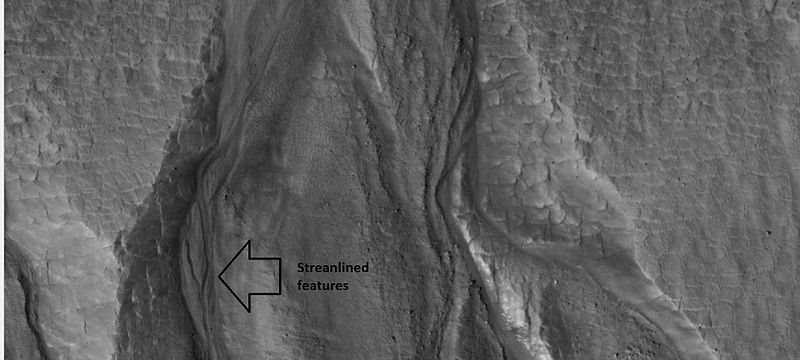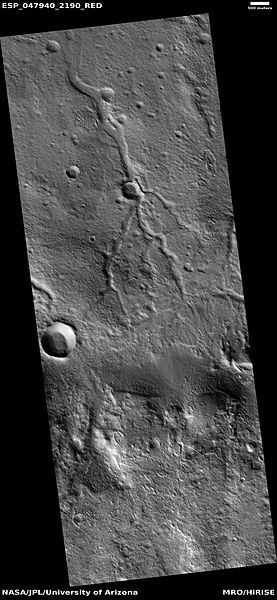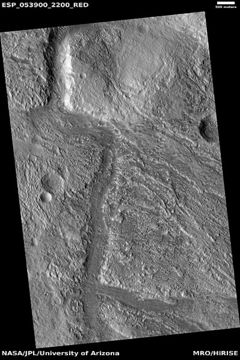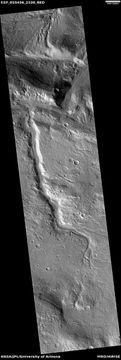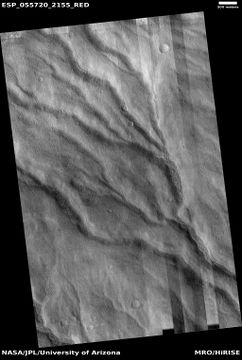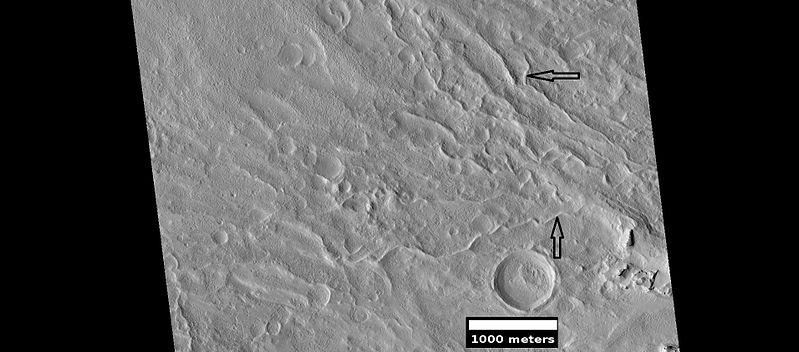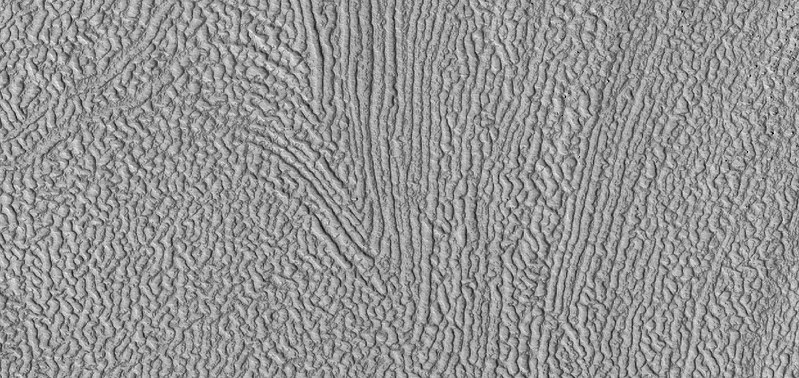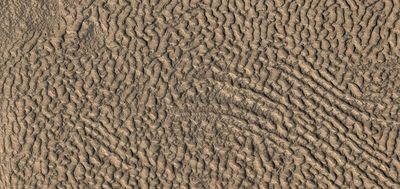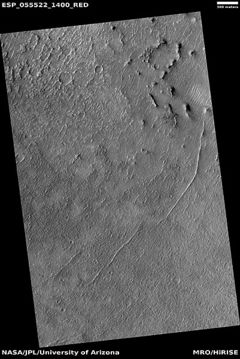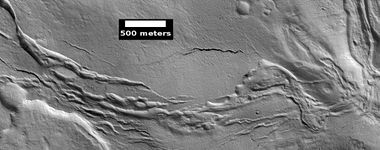Difference between revisions of "Diacria quadrangle"
Suitupshowup (talk | contribs) m |
|||
| (77 intermediate revisions by 3 users not shown) | |||
| Line 1: | Line 1: | ||
| + | {{Mars atlas}} | ||
| + | {| class="wikitable sortable" | ||
| + | |MC-02 | ||
| + | |[[Diacria quadrangle|Diacria]] | ||
| + | |30–65° N | ||
| + | |120–180° W | ||
| + | |[[Mars Quadrangles|Quadrangles]] | ||
| + | |[[Mars Atlas|Atlas]] | ||
| + | |} | ||
| + | Article written by Jim Secosky. Jim is a retired science teacher who has used the Hubble Space Telescope, the Mars Global Surveyor, and HiRISE. | ||
| − | + | In this article, some of the best pictures from a number of spacecraft will show what the landscape looks like in this region. The origins and significance of all features will be explained as they are currently understood. | |
| − | Topographic Map of Diacria Quadrangle | + | <gallery widths="400" heights="300"> |
| + | File:USGS-Mars-MC-2-DiacriaRegion-mola.png| Topographic Map of Diacria Quadrangle Colors relate to elevation | ||
| + | File:PIA00162-Mars-MC-2-DiacriaRegion-19980604.jpg|Image of the Diacria Quadrangle (MC-2). The southeastern part is marked by aureole deposits of the largest known volcano in the solar system, [[Olympus Mons]] | ||
| + | </gallery> | ||
| + | The Diacria quadrangle is one of a series of 30 quadrangle maps of Mars used by the United States Geological Survey (USGS). The quadrangle is located in the northwestern portion of Mars’ western hemisphere and covers 180° to 240° east longitude (120° to 180° west longitude) and 30° to 65° north latitude. It is also referred to as MC-2 (Mars Chart-2).<ref>Davies, M.E.; Batson, R.M.; Wu, S.S.C. "Geodesy and Cartography" in Kieffer, H.H.; Jakosky, B.M.; Snyder, C.W.; Matthews, M.S., Eds. ''Mars.'' University of Arizona Press: Tucson, 1992.</ref> The Diacria quadrangle covers parts of Arcadia Planitia and Amazonis Planitia. | ||
| + | The quadrangle covers an approximate area of 4.9 million square km, or a little over 3% of Mars’ surface area. | ||
| − | + | The Phoenix Lander set down at 68.22° N, 234.25° E (124.75 W). Much of the terrain in the northern Diacria quadrangle probably looks like the scene where Phoenix landed. In this article, some of the best pictures from a number of spacecraft will show what the landscape looks like in this region. The origins and significance of all features will be explained as they are currently understood. | |
| − | |||
| − | |||
| − | |||
==Origin of name== | ==Origin of name== | ||
Diacria is the name of a classical albedo features on Mars located at 48° N and 190° E (170 W) on Mars. The feature was named by Greek astronomer E. M. Antoniadi in 1930 after Diacria, the highlands around Marathon, Greece in north-west Attica, Greece. The name was approved by the International Astronomical Union (IAU) in 1958.<ref>USGS Gazetteer of Planetary Nomenclature. Mars. http://planetarynames.wr.usgs.gov/.</ref> | Diacria is the name of a classical albedo features on Mars located at 48° N and 190° E (170 W) on Mars. The feature was named by Greek astronomer E. M. Antoniadi in 1930 after Diacria, the highlands around Marathon, Greece in north-west Attica, Greece. The name was approved by the International Astronomical Union (IAU) in 1958.<ref>USGS Gazetteer of Planetary Nomenclature. Mars. http://planetarynames.wr.usgs.gov/.</ref> | ||
| + | |||
| + | [[File:Collagediacria 01.jpg|Typical features of Diacria quadrangle as seen by HiRISE under under HiWish program|600pxr| Typical features of Diacria quadrangle]] | ||
| + | |||
| + | Typical features of Diacria quadrangle | ||
| + | |||
==Geologic Setting== | ==Geologic Setting== | ||
| − | The Diacria quadrangle is located at the northwestern edge of the Tharsis volcanic plateau. Parts of this region have volcanic and tectonic features related to the huge volcanoes Olympus Mons to the south and Alba Mons to the east. Much of the tectonic features on Mars are caused by the weight of volcanoes stretching the crust. At present, there is no normal plate tectonic activity on the planet. | + | The Diacria quadrangle is located at the northwestern edge of the Tharsis volcanic plateau. Parts of this region have volcanic and tectonic features related to the huge volcanoes Olympus Mons to the south and Alba Mons to the east. Much of the tectonic features on Mars are caused by the weight of volcanoes stretching the crust. |
| + | |||
| + | At present, there is no normal plate tectonic activity on the planet. | ||
The northern and western areas of the quadrangle lie in the northern lowland plains of Mars and cover portions of Amazonis Planitia (in the south), Arcadia Planitia (west central), and Vastitas Borealis (in the north). The large crater Milankovič (118.4 km in diameter) is located in the north central portion of the quadrangle at 54.7° N, 213.3° E (146.7 W). | The northern and western areas of the quadrangle lie in the northern lowland plains of Mars and cover portions of Amazonis Planitia (in the south), Arcadia Planitia (west central), and Vastitas Borealis (in the north). The large crater Milankovič (118.4 km in diameter) is located in the north central portion of the quadrangle at 54.7° N, 213.3° E (146.7 W). | ||
| Line 27: | Line 46: | ||
Unlike some other places visited on Mars with landers (Viking and Pathfinder), nearly all the rocks near ''Phoenix'' are small. For about as far as the camera can see, the land is flat, but shaped into polygons between 2–3 meters in diameter and is bounded by troughs that are 20 cm to 50 cm deep. These shapes are assumed to be caused by ice in the soil expanding and contracting due to major temperature changes. The microscope showed that the soil on top of the polygons is composed of flat particles (probably a type of clay) together with some rounded particles. Also, unlike other places visited on Mars, the site has no ripples or dunes.<ref>Smith, P. et al. H<sub>2</sub>O at the Phoenix Landing Site. 2009. Science:325. p58-61</ref> Ice is present a few inches below the surface in the middle of the polygons, and along its edges, the ice is at least 8 inches deep. Pictures of the surface under the lander appear to show that the landing rockets have exposed a layer of ice.<ref>Smith, P., et al. 2009. H<sub><sup>2</sub> | Unlike some other places visited on Mars with landers (Viking and Pathfinder), nearly all the rocks near ''Phoenix'' are small. For about as far as the camera can see, the land is flat, but shaped into polygons between 2–3 meters in diameter and is bounded by troughs that are 20 cm to 50 cm deep. These shapes are assumed to be caused by ice in the soil expanding and contracting due to major temperature changes. The microscope showed that the soil on top of the polygons is composed of flat particles (probably a type of clay) together with some rounded particles. Also, unlike other places visited on Mars, the site has no ripples or dunes.<ref>Smith, P. et al. H<sub>2</sub>O at the Phoenix Landing Site. 2009. Science:325. p58-61</ref> Ice is present a few inches below the surface in the middle of the polygons, and along its edges, the ice is at least 8 inches deep. Pictures of the surface under the lander appear to show that the landing rockets have exposed a layer of ice.<ref>Smith, P., et al. 2009. H<sub><sup>2</sub> | ||
| − | + | O at the Phoenix Landing Site. Science: 325, 58-61.</ref> <ref>https://www.nasa.gov/mission_pages/phoenix/news/phoenix-20080530.html </ref>When the ice is exposed to the Martian atmosphere it slowly sublimates.<ref>[http://www.space.com/scienceastronomy/090702-phoenix-soil.html The Dirt on Mars Lander Soil Findings]</ref> That is it changes directly into a gas instead of melting first. Dry ice does this on the Earth. Some dust devils were observed. | |
| − | <gallery class="center" widths=" | + | <gallery class="center" widths="380px" heights="360px"> |
File:Phoenix Sol 0 horizon.jpg|Comparison between polygons photographed by ''Phoenix'' on [[Mars]]... | File:Phoenix Sol 0 horizon.jpg|Comparison between polygons photographed by ''Phoenix'' on [[Mars]]... | ||
File:PSP 008301 2480 cut a.jpg|... and as photographed (in false color) from [[Mars Reconnaissance Orbiter|Mars orbit]]... | File:PSP 008301 2480 cut a.jpg|... and as photographed (in false color) from [[Mars Reconnaissance Orbiter|Mars orbit]]... | ||
| − | File:Patterned ground devon island.jpg|... with patterned ground on Devon Island in the Canadian Arctic | + | File:Patterned ground devon island.jpg|... with patterned ground on Devon Island in the Canadian Arctic |
</gallery> | </gallery> | ||
==Polygonal patterned ground== | ==Polygonal patterned ground== | ||
| − | Polygonal, patterned ground is quite common in some regions of Mars.<ref>http://www.diss.fu-berlin.de/diss/servlets/MCRFileNodeServlet/FUDISS_derivate_000000003198/16_ColdClimateLandforms-13-utopia.pdf?hosts=</ref><ref>Kostama, V.-P., M. Kreslavsky, Head, J. 2006. Recent high-latitude icy mantle in the northern plains of Mars: Characteristics and ages of emplacement. Geophys. Res. Lett. 33 (L11201). doi:10.1029/2006GL025946.K</ref> <ref>Malin, M., Edgett, K. 2001. Mars Global Surveyor Mars Orbiter Camera: Interplanetary cruise through primary mission. J. Geophys. Res. 106 (E10), 23429–23540.</ref> <ref>Milliken, R., et al. 2003. Viscous flow features on the surface of Mars: Observations from high-resolution Mars Orbiter Camera (MOC) images. J. Geophys. Res. 108 (E6). doi:10.1029/2002JE002005.</ref><ref>Mangold, N. 2005. High latitude patterned grounds on Mars: Classification, distribution and climatic control. Icarus 174, 336–359.</ref> <ref>Kreslavsky, M., Head, J. 2000. Kilometer-scale roughness on Mars: Results from MOLA data analysis. J. Geophys. Res. 105 (E11), 26695–26712.</ref> <ref>Seibert, N., J. Kargel. 2001. Small-scale martian polygonal terrain: Implications for liquid surface water. Geophys. Res. Lett. 28 (5), 899–902.</ref> It is | + | Polygonal, patterned ground is quite common in some regions of Mars.<ref>http://www.diss.fu-berlin.de/diss/servlets/MCRFileNodeServlet/FUDISS_derivate_000000003198/16_ColdClimateLandforms-13-utopia.pdf?hosts=</ref><ref>Kostama, V.-P., M. Kreslavsky, Head, J. 2006. Recent high-latitude icy mantle in the northern plains of Mars: Characteristics and ages of emplacement. Geophys. Res. Lett. 33 (L11201). doi:10.1029/2006GL025946.K</ref> <ref>Malin, M., Edgett, K. 2001. Mars Global Surveyor Mars Orbiter Camera: Interplanetary cruise through primary mission. J. Geophys. Res. 106 (E10), 23429–23540.</ref> <ref>Milliken, R., et al. 2003. Viscous flow features on the surface of Mars: Observations from high-resolution Mars Orbiter Camera (MOC) images. J. Geophys. Res. 108 (E6). doi:10.1029/2002JE002005.</ref><ref>Mangold, N. 2005. High latitude patterned grounds on Mars: Classification, distribution and climatic control. Icarus 174, 336–359.</ref> <ref>Kreslavsky, M., Head, J. 2000. Kilometer-scale roughness on Mars: Results from MOLA data analysis. J. Geophys. Res. 105 (E11), 26695–26712.</ref> <ref>Seibert, N., J. Kargel. 2001. Small-scale martian polygonal terrain: Implications for liquid surface water. Geophys. Res. Lett. 28 (5), 899–902.</ref> It is aided by the sublimation of ice from the ground. The ice just disappears into the air, instead of first turning into a liquid. Patterned ground often forms in a mantle layer, called “ latitude dependent mantle,” that fell from the sky when the climate was different.<ref>Hecht, M. 2002. Metastability of water on Mars. Icarus 156, 373–386</ref> <ref>Mustard, J., et al. 2001. Evidence for recent climate change on Mars from the identification of youthful near-surface ground ice. Nature 412 (6845), 411–414.</ref><ref>Kreslavsky, M.A., Head, J.W., 2002. High-latitude Recent Surface Mantle on Mars: New Results from MOLA and MOC. European Geophysical Society XXVII, Nice.</ref> <ref>Head, J.W., Mustard, J.F., Kreslavsky, M.A., Milliken, R.E., Marchant, D.R., 2003. Recent ice ages on Mars. Nature 426 (6968), 797–802.</ref> |
==Latitude dependent mantle== | ==Latitude dependent mantle== | ||
| − | Much of the surface of Mars is covered by a thick smooth mantle that is thought to be a mixture of ice and dust. This ice-rich mantle, a few yards thick, smoothes the land. Because there are few craters on this mantle, the mantle is relatively young. | + | Much of the surface of Mars is covered by a thick smooth mantle that is thought to be a mixture of ice and dust. This ice-rich mantle, a few yards thick, smoothes the land. Because there are few craters on this mantle, it is believed the mantle is relatively young. We have discovered that Mars undergoes major climate changes on a regular basis. |
| − | Changes in Mars's orbit and tilt cause significant changes in the distribution of water ice from polar regions down to latitudes equivalent to Texas. During certain climate periods water vapor leaves polar ice and enters the atmosphere. The water returns to the ground at lower latitudes as deposits of frost or snow mixed with dust. The atmosphere of Mars contains a great deal of fine dust particles. Water vapor condenses on the particles, and then they fall down to the ground due to the additional weight of the water coating. When ice at the top of the mantling layer goes back into the atmosphere, it leaves behind dust, which insulates the remaining ice.<ref name="sciencedaily.com"> | + | |
| + | Changes in Mars's orbit and tilt cause significant changes in the distribution of water ice. It moves from polar regions down to latitudes equivalent to Texas. During certain climate periods water vapor leaves polar ice and enters the atmosphere. The water returns to the ground at lower latitudes as deposits of frost or snow mixed with dust. The atmosphere of Mars contains a great deal of fine dust particles. Water vapor condenses on the particles, and then they fall down to the ground due to the additional weight of the water coating. When ice at the top of the mantling layer goes back into the atmosphere, it leaves behind dust, which insulates the remaining ice.<ref name="sciencedaily.com">LA NASA/Jet Propulsion Laboratory |date=December 18, 2003 | title= Mars May Be Emerging From An Ice Age |work= ScienceDaily |accessdate=February 19, 2009 |url= https://www.sciencedaily.com/releases/2003/12/031218075443.htm<nowiki> }}</nowiki></ref> | ||
| − | [[File:52530 2190mantle.jpg|thumb|400px|left|Close view of mantle]] | + | [[File:52530 2190mantle.jpg|thumb|400px|left|Close view of mantle Because it contains ice, water can be extracted from it for future colonists.]] |
[[File:54996 2155mantle.jpg|thumb|400px|center|Close view of mantle, as seen by HiRISE under the HiWish program]] | [[File:54996 2155mantle.jpg|thumb|400px|center|Close view of mantle, as seen by HiRISE under the HiWish program]] | ||
| Line 50: | Line 70: | ||
==Western flank of Alba Mons== | ==Western flank of Alba Mons== | ||
| − | The western flank of the Alba Mons volcano makes up the eastern and southeastern edge of the quadrangle. In terms of area, Alba Mons (formerly, Alba Patera) is the largest volcanic feature on Mars. The flank has a very low slope (l° or less) and is characterized by lava flows and an outwardly radiating array of ridges and channels. Some of the channels have a drainage pattern that resembles that formed by rain water on the slopes of terrestrial volcanoes. However, many other channels on the flanks of Alba Mons were clearly formed by flowing lava.<ref>Carr, M.H. ''The Surface of Mars;'' Cambridge University Press: New York, 2006.</ref> | + | The western flank of the Alba Mons volcano makes up the eastern and southeastern edge of the quadrangle. In terms of area, Alba Mons (formerly, [[Alba Patera]]) is the largest volcanic feature on Mars. The flank has a very low slope (l° or less) and is characterized by lava flows and an outwardly radiating array of ridges and channels. Some of the channels have a drainage pattern that resembles that formed by rain water on the slopes of terrestrial volcanoes. However, many other channels on the flanks of Alba Mons were clearly formed by flowing lava.<ref>Carr, M.H. ''The Surface of Mars;'' Cambridge University Press: New York, 2006.</ref> |
| − | The western flank of the volcano also contains some NW-SE trending grabens (Cyane Fossae). An image from High Resolution Imaging Science Experiment (HiRISE) on the [[Mars Reconnaissance Orbiter]] (MRO) beautifully shows a line of rimless pit craters in Cyane Fossae. The pits may have formed by the collapse of surface materials into open fractures created as magma intruded the subsurface rock to form dikes.<ref>University of Arizona HiRISE Website. http://hirise.lpl.arizona.edu/PSP_010345_2150.</ref> | + | The western flank of the volcano also contains some NW-SE trending grabens (Cyane Fossae). Grabens form when the crust is stretched, resulting in movements along faults. An image from High Resolution Imaging Science Experiment (HiRISE) on the [[Mars Reconnaissance Orbiter]] (MRO) beautifully shows a line of rimless pit craters in Cyane Fossae. The pits may have formed by the collapse of surface materials into open fractures created as magma intruded the subsurface rock to form dikes.<ref>University of Arizona HiRISE Website. http://hirise.lpl.arizona.edu/PSP_010345_2150.</ref> |
[[File:Cyane Fossae.JPG|thumb|400px|left|Cyane Fossae]] | [[File:Cyane Fossae.JPG|thumb|400px|left|Cyane Fossae]] | ||
| − | [[File:PSP 003370 2140cyane.jpg|thumb|400px|center|Pit craters in Cyane Fossae, as seen by HiRISE]] | + | [[File:PSP 003370 2140cyane.jpg|thumb|400px|center|Pit craters in Cyane Fossae, as seen by HiRISE Pits may have formed by the collapse of surface materials into open fractures or voids.]] |
==Acheron Fossae== | ==Acheron Fossae== | ||
| Line 63: | Line 83: | ||
[[File:Acheronchannelsctx.jpg|600pxr|Wide view of channels, as seen by CTX]] | [[File:Acheronchannelsctx.jpg|600pxr|Wide view of channels, as seen by CTX]] | ||
| − | + | Wide view of channels in Acheron Fossae, as seen by CTX | |
| − | <gallery class="center" widths=" | + | <gallery class="center" widths="380px" heights="360px"> |
File:ESP 045804 2200channel.jpg|Channel in Acheron Fossae, as seen by HiRISE under HiWish program | File:ESP 045804 2200channel.jpg|Channel in Acheron Fossae, as seen by HiRISE under HiWish program | ||
| Line 76: | Line 96: | ||
| − | Layers and [[dark slope streaks]] in Lycus Sulci, as seen by HiRISE under HiWish program | + | Layers and [[dark slope streaks]] in Lycus Sulci, as seen by HiRISE under HiWish program Dark slope streaks occur when bright dust moves away and exposes dark underlying rock. |
| − | Lycus Sulci (24.6° N, 219° E {141 W}) is the name applied to the northwestern portion of a larger terrain feature that partially encircles the volcano, Olympus Mons, and extends up to 750 km from the giant shield volcano’s base. Shield volcanoes have a very gentle slope, like a shield that is sitting on the ground. This feature, called the Olympus Mons aureole, consists of several large lobes and has a distinctive corrugated or grooved surface texture. East of Olympus Mons, the aureole is partially covered by lava flows, but where it is exposed it goes by different names (Gigas Sulci, for example).The origin of the aureole remains debated, but it was likely formed by huge landslides or gravity-driven thrust faults that sloughed off the edges of the Olympus Mons shield.<ref>Cattermole P. ''Mars: the Mystery Unfolds;'' Oxford University Press: New York, 2001.</ref> | + | Lycus Sulci (24.6° N, 219° E {141 W}) is the name applied to the northwestern portion of a larger terrain feature that partially encircles the volcano, Olympus Mons, and extends up to 750 km from the giant shield volcano’s base. Shield volcanoes have a very gentle slope, like a shield that is sitting on the ground. This feature, called the Olympus Mons aureole, consists of several large lobes and has a distinctive corrugated or grooved surface texture. East of [[Olympus Mons]], the aureole is partially covered by lava flows, but where it is exposed it goes by different names (Gigas Sulci, for example).The origin of the aureole remains debated, but it was likely formed by huge landslides or gravity-driven thrust faults that sloughed off the edges of the Olympus Mons shield.<ref>Cattermole P. ''Mars: the Mystery Unfolds;'' Oxford University Press: New York, 2001.</ref> |
| Line 88: | Line 108: | ||
[[File:Lycussulcictx.jpg|600pxr|Flows and channels at the northwest margin of the Lycus Sulci, as seen by CTX]] | [[File:Lycussulcictx.jpg|600pxr|Flows and channels at the northwest margin of the Lycus Sulci, as seen by CTX]] | ||
| − | + | Flows and channels at the northwest margin of the Lycus Sulci, as seen by CTX | |
==Arcadia Planitia and Southern Vastitas Borealis== | ==Arcadia Planitia and Southern Vastitas Borealis== | ||
| Line 94: | Line 114: | ||
North and east of the Erebus Montes are low-lying plains that characterize a large part of the Diacria Quadrangle and of the Martian northern hemisphere in general. | North and east of the Erebus Montes are low-lying plains that characterize a large part of the Diacria Quadrangle and of the Martian northern hemisphere in general. | ||
Medium resolution [[Mariner 9]] and Viking spacecraft images from the 1970s show that large portions of Arcadia Planitia have an overall blotchy light and dark appearance. At higher resolution, landforms commonly consist of lobate flow fronts; small channel segments; wrinkle-ridge; pedestal craters; and low, isolated volcano-like hills with summit craters.<ref>Tanaka, K.L.; Scott, D.H.; Greely, R. "Global Stratigraphy" in Kieffer, H.H.; Jakosky, B.M.; Snyder, C.W.; Matthews, M.S., Eds. ''Mars;'' University of Arizona Press: Tucson, 1992.</ref> Mars Orbiter Laser Altimeter ( MOLA) images reveal numerous large, shallowly buried craters, suggesting that an old cratered surface lies under a layer of younger material. | Medium resolution [[Mariner 9]] and Viking spacecraft images from the 1970s show that large portions of Arcadia Planitia have an overall blotchy light and dark appearance. At higher resolution, landforms commonly consist of lobate flow fronts; small channel segments; wrinkle-ridge; pedestal craters; and low, isolated volcano-like hills with summit craters.<ref>Tanaka, K.L.; Scott, D.H.; Greely, R. "Global Stratigraphy" in Kieffer, H.H.; Jakosky, B.M.; Snyder, C.W.; Matthews, M.S., Eds. ''Mars;'' University of Arizona Press: Tucson, 1992.</ref> Mars Orbiter Laser Altimeter ( MOLA) images reveal numerous large, shallowly buried craters, suggesting that an old cratered surface lies under a layer of younger material. | ||
| − | At the resolution of the Mars Orbital Camera (MOC) on the Mars Global Surveyor spacecraft (around several meters per pixel), much of the northern plains has a distinctly stippled, pitted texture that causes the ground to resemble the surface of a basketball or orange rind. This texture is likely caused by a mantle of ice and dust covering the landscape. The small hollows and pits formed as the ice disappeared (sublimed). | + | At the resolution of the Mars Orbital Camera (MOC) on the [[Mars Global Surveyor]] spacecraft (around several meters per pixel), much of the northern plains has a distinctly stippled, pitted texture that causes the ground to resemble the surface of a basketball or orange rind. This texture is likely caused by a mantle of ice and dust covering the landscape. The small hollows and pits formed as the ice disappeared (sublimed). |
| − | The geologic history and origin of the northern plains are complex and still poorly understood. Many of the landforms resemble periglacial features seen on Earth, such as moraines, | + | The geologic history and origin of the northern plains are complex and still poorly understood. Many of the landforms resemble periglacial features seen on Earth, such as moraines, ice-wedged polygons, and pingos. The term "periglacial" refers to features found near glaciers. These periglacial features may be important for tracking down a water supply for future colonists. Arcadia Planitia and Vastitas Borealis likely consist of a hodgepodge of old lava flows, ice-related features, and reworked sediments of diverse origin. Some theorize that the northern plains were once covered by oceans or large lakes. <ref>https://www.ncbi.nlm.nih.gov/pmc/articles/PMC4872529/</ref> <ref>Carr, M. & J. Head. 2010 Geologic history of Mars. Earth and Planetary Science Letters. 294. 185-203.</ref> <ref>Clifford, S. M.; Parker, T. J. (2001). "The Evolution of the Martian Hydrosphere: Implications for the Fate of a Primordial Ocean and the Current State of the Northern Plains". Icarus. 154 (1): 40–79. Bibcode:2001Icar..154...40C. doi:10.1006/icar.2001.6671</ref> <ref>Baker, V. R.; Strom, R. G.; Gulick, V. C.; Kargel, J. S.; Komatsu, G.; Kale, V. S. (1991). "Ancient oceans, ice sheets and the hydrological cycle on Mars". Nature. 352 (6336): 589–594. </ref> <ref>Lucchitta, B. et al. 1986. Sedimentary deposits in the northern lowland plains, Mars. Proc. Lunar planet. Conf. 17th, part 1, j. Geophys. Res., 91, suppl., E166-E174.</refMars’ atmospheric history derived from upper-atmosphere measurements of 38Ar/36Ar. Science 355 (6332): 1408-1410; doi: 10.1126/science.aai7721 </ref> <ref>http://www.sci-news.com/space/maven-martian-atmosphere-lost-space-04750.html</ref> There is even evidence that two tsunamis occurred when asteroids struck an ocean. <ref>http://astrobiology.com/2016/05/ancient-tsunami-evidence-on-mars-reveals-life-potential.html </ref> <ref>Rodriguez, J.; et al. 2016. "Tsunami waves extensively resurfaced the shorelines of an early Martian ocean. :" (PDF). Scientific Reports / 47th Lunar and Planetary Science Conference. 6:</ref> However, despite decades of accumulated evidence for a Martian ocean, the idea remains controversial. <ref>Head, J., et al. 2018. TWO OCEANS ON MARS?: HISTORY, PROBLEMS AND PROSPECTS. 49th Lunar and Planetary Science Conference 2018 (LPI Contrib. No. 2083). 2194.pdf</ref> |
[[File:Arcadia Planitia Texture.jpg|thumb|400px|left|Surface texture of northern Arcadia Planitia at high resolution.]] | [[File:Arcadia Planitia Texture.jpg|thumb|400px|left|Surface texture of northern Arcadia Planitia at high resolution.]] | ||
| Line 106: | Line 126: | ||
Large impacts often create swarms of small secondary craters from the debris that is blasted out as a consequence of the impact.<ref>http://www.uahirise.org/epo/nuggets/expanded-secondary.pdf</ref> Studies of a type of secondary craters, called expanded craters, have given us insights into places where abundant ice may be present in the ground. Expanded craters have lost their rims, this may be because any rim that was once present has collapsed into the crater during expansion or, lost its ice, if composed of ice. | Large impacts often create swarms of small secondary craters from the debris that is blasted out as a consequence of the impact.<ref>http://www.uahirise.org/epo/nuggets/expanded-secondary.pdf</ref> Studies of a type of secondary craters, called expanded craters, have given us insights into places where abundant ice may be present in the ground. Expanded craters have lost their rims, this may be because any rim that was once present has collapsed into the crater during expansion or, lost its ice, if composed of ice. | ||
| − | Excess ice (ice in addition to what is in the pores of the ground) is widespread throughout the Martian mid-latitudes, especially in Arcadia Planitia. In this region, are many expanded secondary craters that probably form from impacts that destabilize a subsurface layer of excess ice, which subsequently sublimates. With sublimation the ice changes directly from a solid to gaseous form. In the impact, excess ice is broken up, resulting in an increase in surface area. Ice will sublimate much more if there is more surface area. After the ice disappears into the atmosphere, dry soil material will collapse and cause the crater diameter to become larger.<ref>Viola, D., et al. 2014. EXPANDED CRATERS IN ARCADIA PLANITIA: EVIDENCE FOR >20 MYR OLD SUBSURFACE ICE. Eighth International Conference on Mars (2014). 1022pdf.</ref> Places on Mars that display expanded craters may indicate where future colonists can find water ice. | + | Excess ice (ice in addition to what is in the pores of the ground) is widespread throughout the Martian mid-latitudes, especially in Arcadia Planitia. In this region, are many expanded secondary craters that probably form from impacts that destabilize a subsurface layer of excess ice, which subsequently sublimates. With [[sublimation]] the ice changes directly from a solid to gaseous form. In the impact, excess ice is broken up, resulting in an increase in surface area. Ice will sublimate much more if there is more surface area. After the ice disappears into the atmosphere, dry soil material will collapse and cause the crater diameter to become larger.<ref>Viola, D., et al. 2014. EXPANDED CRATERS IN ARCADIA PLANITIA: EVIDENCE FOR >20 MYR OLD SUBSURFACE ICE. Eighth International Conference on Mars (2014). 1022pdf.</ref> Places on Mars that display expanded craters may indicate where future colonists can find water ice. |
==Ice exposed in new craters== | ==Ice exposed in new craters== | ||
| − | A study reported in the journal Science in | + | [[File:Iceincraterscomparison.jpg|600 pxr|Ice exposed in new crater]] |
| + | |||
| + | Ice exposed in new crater (photo on right shows ice disappearing) | ||
| + | |||
| + | A study reported in the journal Science in 2009 shows that some newly formed craters have excavated clean, water ice from just below the surface in five locations on Mars. <ref>Byrne, S. et al. 2009. Distribution of Mid-Latitude Ground Ice on Mars from New Impact Craters: 329.1674-1676</ref> After a short time, the ice disappears, subliming into the atmosphere. The ice is only a few meters deep. The ice was confirmed with the Compact Imaging Spectrometer (CRISM) on board the [[Mars Reconnaissance Orbiter]] (MRO). The ice was found in a total of 5 locations. One of the locations (Site 5) is in the Diacria quadrangle at about 46° N, 182° E (178 W).<ref>http://www.space.com/scienceastronomy/090924-mars-crater-ice.html</ref><ref>http://news.aol.com/article/nasa-spacecraft-sees-ice-on-mars-exposed/686020</ref> <ref>http://nasa.gov/mission/MRO/news/mro20090924.html</ref> | ||
This discovery is significant because it shows the presence of subsurface ice at latitudes further south than expected and proves that future colonists on Mars will be able to obtain water from a wide variety of locations. The ice can be dug up, melted, and then taken apart to provide fresh oxygen and hydrogen for rocket fuel. Hydrogen is the powerful fuel used by the space shuttle main engines. Robotic machines may just be sent out to gather water for colonists. | This discovery is significant because it shows the presence of subsurface ice at latitudes further south than expected and proves that future colonists on Mars will be able to obtain water from a wide variety of locations. The ice can be dug up, melted, and then taken apart to provide fresh oxygen and hydrogen for rocket fuel. Hydrogen is the powerful fuel used by the space shuttle main engines. Robotic machines may just be sent out to gather water for colonists. | ||
| + | |||
| + | <gallery class="center" widths="380px" heights="360px"> | ||
| + | |||
| + | File:ESP 025840 2240-3icecrater.gif|Ice disappering after being exposed by impact. | ||
| + | |||
| + | </gallery> | ||
==Dark slope streaks== | ==Dark slope streaks== | ||
| − | [[File:Dark streaks in Diacriamgs.JPG|thumb|400px|left|Dark streaks in Diacria, as seen by [[Mars Global Surveyor]], under the MOC Public Targeting Program. When they age, streaks get lighter in color.]] | + | [[File:Dark streaks in Diacriamgs.JPG|thumb|400px|left|Dark streaks in Diacria, as seen by [[Mars Global Surveyor]], under the MOC Public Targeting Program. When they age, streaks get lighter in color. When bright dust avalanches down slopes, it uncovers the dark surface below.]] |
| − | Many places on Mars show dark slope | + | Many places on Mars show [[dark slope streaks]] on steep slopes, such as impact crater walls. It seems that the youngest streaks are dark and they become lighter with age. Often they begin as a small narrow spot then widen and extend downhill for hundreds of meters. Several ideas have been advanced to explain the streaks. The streaks appear in areas covered with dust. Much of the Martian surface is covered with dust because at more or less regular intervals dust settles out of the atmosphere covering everything. We know a lot about this dust because the solar panels of Mars rovers get covered with dust. The power of the Rovers has been saved many times by dust devils that have cleared the panels and boosted their power.<ref>https://www.sciencedaily.com/releases/2009/02/090217101110.htm</ref> |
| − | It is most generally accepted that the streaks represent avalanches of dust. Streaks appear in areas covered with dust. When a thin layer of dust is removed, the underlying surface appears dark. Much of the Martian surface is covered with dust. Dust storms are frequent, especially when the spring season begins in the southern hemisphere. At that time, Mars is 40% closer to the sun. | + | It is most generally accepted that the streaks represent avalanches of dust. Streaks appear in areas covered with dust. When a thin layer of dust is removed, the underlying surface appears dark. Much of the Martian surface is covered with dust. Dust storms are frequent, especially when the spring season begins in the southern hemisphere. At that time, Mars is 40% closer to the sun. Also, every few years, the entire planet is engulfed in a global dust storm. When NASA's [[Mariner 9]] craft arrived there, nothing could be seen through the dust storm.<ref>ISBN|0-517-00192-6</ref><ref name="Kieffer1992"><nowiki>{{cite book|author=Hugh H. Kieffer|title=Mars|url=</nowiki>https://books.google.com/books?id=NoDvAAAAMAAJ|accessdate=7 March 2011|year=1992|publisher=University of Arizona Press</ref> Other global dust storms have also been observed, since that time, including a major one in 2018. |
| − | |||
| − | |||
| + | Research, published in 2012 in Icarus, found that some dark streaks were initiated by airblasts from meteorites traveling at supersonic speeds. The team of scientists was led by Kaylan Burleigh, an undergraduate at the University of Arizona. After counting some 65,000 dark streaks around the impact site of a group of 5 new craters, the team discovered patterns. The number of streaks was greatest closer to the impact site. So, the impact somehow probably caused the streaks. Also, the distribution of the streaks formed a pattern with two wings extending from the impact site. The curved wings resembled scimitars, curved knives. This pattern suggests that an interaction of airblasts from the group of meteorites shook dust loose enough to start dust avalanches that formed the many dark streaks. At first it was thought that the shaking of the ground from the impact caused the dust avalanches, but if that was the case the dark streaks would have been arranged symmetrically around the impacts, rather than being concentrated into curved shapes.<ref>Kaylan J. Burleigh, Henry J. Melosh, Livio L. Tornabene, Boris Ivanov, Alfred S. McEwen, Ingrid J. Daubar. Impact air blast triggers dust avalanches on Mars. Icarus, 2012; 217 (1): 194</ref> <ref>http://redplanet.asu.edu/</ref> | ||
| + | Dark streaks can be seen in some of the images below and to the left. | ||
[[File: 23677streakslabeled.jpg|600pxr|Young and old dark streaks, as seen by HiRISE under HiWish program]] | [[File: 23677streakslabeled.jpg|600pxr|Young and old dark streaks, as seen by HiRISE under HiWish program]] | ||
| − | Young and old dark streaks, as seen by HiRISE under HiWish program | + | Young and old dark streaks, as seen by HiRISE under HiWish program |
| + | |||
| + | ==Dust and dust devil tracks== | ||
| + | |||
| + | [[File:Milankovic Craterdevils.jpg|600pxr|Dunes and dust devil tracks in the center of Milankovic Crater The pattern of the tracks have been shown to change every few months.]] | ||
| − | + | Dunes and dust devil tracks in the center of Milankovic Crater Dust devils are like tiny tornados, the remove bright dust. | |
| − | |||
| − | Large portions of the Martian surface are blanketed with bright reddish-brown dust. The dust particles are typically less than 40 micrometres in size and are composed of iron oxide minerals (rust).<ref>Barlow, N. ''Mars: An Introduction to Its Interior, Surface, and Atmosphere;'' Cambridge University Press: New York, 2008.</ref> Data from the Thermal Emission Spectrometer (TES) on the Mars Global Surveyor spacecraft has allowed planetary scientists to estimate the amount of dust cover for broad swaths of the planet.<ref>Ruff, S.W.; Christensen, P.R. "Bright and Dark Regions on Mars: Particle Size and Mineralogical Characteristics Based on Thermal Emission Spectrometer Data," ''Journal of Geophysical Research,'' 107, E12, 5127 | + | Large portions of the Martian surface are blanketed with bright reddish-brown dust. The dust particles are typically less than 40 micrometres in size and are composed of iron oxide minerals (rust).<ref>Barlow, N. ''Mars: An Introduction to Its Interior, Surface, and Atmosphere;'' Cambridge University Press: New York, 2008.</ref> Data from the Thermal Emission Spectrometer (TES) on the Mars Global Surveyor spacecraft has allowed planetary scientists to estimate the amount of dust cover for broad swaths of the planet.<ref>Ruff, S.W.; Christensen, P.R. 2002. "Bright and Dark Regions on Mars: Particle Size and Mineralogical Characteristics Based on Thermal Emission Spectrometer Data," ''Journal of Geophysical Research,'' 107, E12, 5127.</ref> In general, the Diacria quadrangle is extremely dusty, particularly in Arcadia Planitia and the region around the flank of Alba Mons and the Olympus Mons aureole in the southeastern portion of the quadrangle. A few large patches of relatively low dust cover occur in Amazonis Planitia and in the northwest corner of the quadrangle.<ref>TES Dust Cover Index. http://www.mars.asu.edu/~ruff/DCI/dci.html.</ref> |
Many areas on Mars, including the Diacria quadrangle, experience the passage of giant [[dust devils]]. When a dust devil goes by it blows away the coating of dust and exposes the underlying dark surface. Dust devils have been seen from the ground and high overhead from orbit. They have frequently cleaned the dust off of the solar panels of the two Rovers on Mars, thereby greatly extending their lives.<ref>http://marsrovers.jpl.nasa.gov/gallery/press/spirit/20070412a.html</ref> The twin Rovers were designed to last for 3 months, instead they both lasted more than six years. The pattern of the tracks have been shown to change every few months.<ref>url=http://mars.jpl.nasa.gov/spotlight/KenEdgett.html</ref> <ref>http://mars.jpl.nasa.gov/spotlight/kenEdgett.html </ref> | Many areas on Mars, including the Diacria quadrangle, experience the passage of giant [[dust devils]]. When a dust devil goes by it blows away the coating of dust and exposes the underlying dark surface. Dust devils have been seen from the ground and high overhead from orbit. They have frequently cleaned the dust off of the solar panels of the two Rovers on Mars, thereby greatly extending their lives.<ref>http://marsrovers.jpl.nasa.gov/gallery/press/spirit/20070412a.html</ref> The twin Rovers were designed to last for 3 months, instead they both lasted more than six years. The pattern of the tracks have been shown to change every few months.<ref>url=http://mars.jpl.nasa.gov/spotlight/KenEdgett.html</ref> <ref>http://mars.jpl.nasa.gov/spotlight/kenEdgett.html </ref> | ||
| Line 138: | Line 171: | ||
| − | [[File:ESP 024943straightvalleysboxed.jpg|thumb| | + | [[File:ESP 024943straightvalleysboxed.jpg|thumb|300px|left|Depressions with straight southern walls, as seen by HiRISE under HiWish program. Box indicates part enlarged in images below.]] |
| − | |||
| − | |||
| − | |||
| − | |||
| − | |||
| + | [[File:24943straightedgeshadows.jpg|thumb|300px|center||Enlargement of above image of straight walled depression Note that the southern wall is dark compared to the northern wall.]] | ||
| − | + | [[File:24943straightedgeshawodsclose.jpg|thumb|300px|right|Further enlargement of above image]] | |
| − | File: | ||
| − | |||
| − | |||
| − | |||
| − | The triangular depressions visible in Milankovic Crater contain water ice in the straight wall that faces the pole, according to a new study. This discovery was hailed as a | + | The triangular depressions visible in Milankovic Crater contain water ice in the straight wall that faces the pole, according to a new study.<ref>https://www.uahirise.org/ESP_071573_2350</ref> This discovery was hailed as a big deal because it means pure water may be easily acquired for future cities on Mars.<ref> Dundas, E., et al. 2018. Exposed subsurface ice sheets in the martian mid-latitudes. Science. 359. 199.</ref> Eight sites were found with Milankovic Crater being the only one in the northern hemisphere. This discovery is important because the ice lies under only a meter or two of cover. Research was conducted with instruments on board the [[Mars Reconnaissance Orbiter]] (MRO).<ref name="exposed ice 2018">[https://www.jpl.nasa.gov/news/news.php?feature=7038 Steep Slopes on Mars Reveal Structure of Buried Ice]. NASA Press Release. 11 January 2018.</ref> <ref>[http://www.sciencemag.org/news/2018/01/ice-cliffs-spotted-mars Ice cliffs spotted on Mars]. ''Science News''. Paul Voosen. 11 January 2018.</ref> <ref>https://www.slideshare.net/sacani/exposed-subsurface-ice-sheets-in-the-martian-midlatitudes</ref> <ref>http://spaceref.com/mars/steep-slopes-on-mars-reveal-structure-of-buried-ice.html</ref> <ref>Colin M. Dundas, et al. ''Science'', 12 January 2018. Vol. 359, Issue 6372, pp. 199-201.</ref> |
The following images are ones referred to in this study of subsurface ice sheets.<ref>Supplementary Materials Exposed subsurface ice sheets in the Martian mid-latitudes Colin M. Dundas, Ali M. Bramson, Lujendra Ojha, James J. Wray, Michael T. Mellon, Shane Byrne, Alfred S. McEwen, Nathaniel E. Putzig, Donna Viola, Sarah Sutton, Erin Clark, John W. Holt</ref> | The following images are ones referred to in this study of subsurface ice sheets.<ref>Supplementary Materials Exposed subsurface ice sheets in the Martian mid-latitudes Colin M. Dundas, Ali M. Bramson, Lujendra Ojha, James J. Wray, Michael T. Mellon, Shane Byrne, Alfred S. McEwen, Nathaniel E. Putzig, Donna Viola, Sarah Sutton, Erin Clark, John W. Holt</ref> | ||
| − | <gallery class="center" widths=" | + | <gallery class="center" widths="380px" heights="360px"> |
| − | File:ESP 045290 2350icelayers.jpg|Wide view of part of Milankovic Crater | + | File:ESP 045290 2350icelayers.jpg|Wide view of part of Milankovic Crater Many depressions here contain ice in their walls. |
| − | File:ESP 045290 2350icelayersscale.jpg|Close view from a previous image | + | File:ESP 045290 2350icelayersscale.jpg|Close view from a previous image The triangular shape of some depressions are noted. The area in the box is enlarged in following images. |
| − | File:45290 2350icelayerscloseer.jpg |Close view of depression | + | File:45290 2350icelayerscloseer.jpg |Close view of depression Arrows indicate where there is a very thin, 1-2 meter covering on what is believed to be ice. |
</gallery> | </gallery> | ||
| Line 167: | Line 192: | ||
[[File:26420gullieswide.jpg|thumb|400px|left|File:26420gullieswide.jpg|Wide view of group of gullies, as seen by HiRISE under HiWish program. Note that part of this image is enlarged in the following image.]] | [[File:26420gullieswide.jpg|thumb|400px|left|File:26420gullieswide.jpg|Wide view of group of gullies, as seen by HiRISE under HiWish program. Note that part of this image is enlarged in the following image.]] | ||
| − | + | [[Martian gullies]] are small, incised networks of narrow channels and their associated downslope sediment deposits. They are named for their resemblance to terrestrial gullies. First discovered on images from [[Mars Global Surveyor]], they occur on steep slopes, especially on the walls of craters. Usually, each gully has an ''alcove'' at its head, a fan-shaped ''apron'' at its base, and a single thread of carved ''channel'' linking the two, giving the whole gully an hourglass shape.<ref name="Malin, M. 2000">Malin, M., Edgett, K. 2000. Evidence for recent groundwater seepage and surface runoff on Mars. Science 288, 2330–2335.</ref> They are believed to be relatively young because they display few, if any, craters. | |
| − | At first, many researchers believed that the process that cut the gullies involved liquid water. However, | + | At first, many researchers believed that the process that cut the gullies involved liquid water. However, many scientists today believe that gullies that are being formed today are from chunks of dry ice moving down slopes.<ref>Harrington |first=J.D. |last2=Webster |first2=Guy |title=RELEASE 14-191 – NASA Spacecraft Observes Further Evidence of Dry Ice Gullies on Mars |url=http://www.nasa.gov/press/2014/july/nasa-spacecraft-observes-further-evidence-of-dry-ice-gullies-on-mars |date=July 10, 2014 |work=[[NASA]] |accessdate=July 10, 2014 </ref> In the past, water may have been involved though. The pictures below show examples of gullies in Diacria quadrangle. |
| Line 177: | Line 202: | ||
==Channels== | ==Channels== | ||
| − | There is | + | There is abundant evidence that water once flowed in river valleys on Mars.<ref>Baker, V., et al. 2015. Fluvial geomorphology on Earth-like planetary surfaces: a review. Geomorphology. 245, 149–182.</ref><ref>Carr, M. 1996. in Water on Mars. Oxford Univ. Press.</ref> Images of curved channels have been seen in images from Mars spacecraft dating back to the early seventies with the [[Mariner 9]] orbiter.<ref>Baker, V. 1982. The Channels of Mars. Univ. of Tex. Press, Austin, TX</ref><ref>Baker, V., R. Strom, R., V. Gulick, J. Kargel, G. Komatsu, V. Kale. 1991. Ancient oceans, ice sheets and the hydrological cycle on Mars. Nature 352, 589–594.</ref> <ref>Carr, M. 1979. Formation of Martian flood features by release of water from confined aquifers. J. Geophys. Res. 84, 2995–300.</ref> <ref>Komar, P. 1979. Comparisons of the hydraulics of water flows in Martian outflow channels with flows of similar scale on Earth. Icarus 37, 156–181.</ref> Indeed, a study published in June 2017, calculated that the volume of water needed to carve all the channels on Mars was even larger than the proposed ocean that the planet may have had. Water was probably recycled many times from the ocean to rainfall around Mars.<ref>http://spaceref.com/mars/how-much-water-was-needed-to-carve-valleys-on-mars.html</ref><ref>Luo, W., et al. 2017. New Martian valley network volume estimate consistent with ancient ocean and warm and wet climate. Nature Communications 8. Article number: 15766 (2017). doi:10.1038/ncomms15766</ref> |
[[File:ESP 047940 2190channelnetwork.jpg|600pxr|Channel network, as seen by HiRISE under HiWish program]] | [[File:ESP 047940 2190channelnetwork.jpg|600pxr|Channel network, as seen by HiRISE under HiWish program]] | ||
| Line 183: | Line 208: | ||
Channel network, as seen by HiRISE under HiWish program | Channel network, as seen by HiRISE under HiWish program | ||
| − | <gallery class="center" widths=" | + | <gallery class="center" widths="380px" heights="360px"> |
| − | File:ESP 053900 2200channel.jpg|Channel | + | File:ESP 053900 2200channel.jpg|Channel The right angles of this channel may be due to tectonic forces that made areas of weakness. |
| − | File:ESP 055456 2190channels.jpg|Channels | + | File:ESP 055456 2190channels.jpg|Channels |
| − | File:ESP 055720 2155channels.jpg|Channel network | + | File:ESP 055720 2155channels.jpg|Channel network |
</gallery> | </gallery> | ||
==Inverted Relief== | ==Inverted Relief== | ||
| − | + | Inverted relief, inverted topography, or topographic inversion refers to landscape features that have reversed their elevation relative to other features. It most often occurs when low areas of a landscape become filled with lava or sediment that hardens into material that is more resistant to erosion than the material that surrounds it. Differential erosion then removes the less resistant surrounding material, leaving behind the younger resistant material, which may then appear as a ridge where previously there was a valley. Terms such as "inverted valley" or "inverted channel" are used to describe such features.<ref name="PainOthers1995a">Pain, C.F., and C.D. Ollier, 1995, ''Inversion of relief - a component of landscape evolution.'' Geomorphology. 12(2):151-165.</ref> Inverted relief has been observed on Earth and in many locations on Mars.<ref name="PainOthers2007a">Pain, C.F., J.D.A. Clarke, and M. Thomas, 2007, ''Inversion of relief on Mars.'' Icarus. 190(2):478–491.</ref> | |
[[File:ESP 036362 2195inverted.jpg|600pxr|Inverted stream channels on crater slope, as seen by HiRISE under HiWish program]] | [[File:ESP 036362 2195inverted.jpg|600pxr|Inverted stream channels on crater slope, as seen by HiRISE under HiWish program]] | ||
| − | Inverted stream channels on crater slope, as seen by HiRISE under HiWish program | + | Inverted stream channels on crater slope, as seen by HiRISE under HiWish program |
==Brain terrain== | ==Brain terrain== | ||
| Line 208: | Line 233: | ||
| − | + | ||
[[File:54996 2155brainscolor.jpg|thumb|400px|center|Close, color view of brain terrain, as seen by HiRISE under HiWish program]] | [[File:54996 2155brainscolor.jpg|thumb|400px|center|Close, color view of brain terrain, as seen by HiRISE under HiWish program]] | ||
| Line 214: | Line 239: | ||
==Other scenes in Diacria quadrangle== | ==Other scenes in Diacria quadrangle== | ||
| + | <gallery class="center" widths="380px" heights="360px"> | ||
| + | |||
| + | File:ESP 055522 1400ridge.jpg|Ridges that may represent dikes Dikes are caused by magma moving underground | ||
| − | + | File:ESP 057250 2165cracks.jpg|Large and small cracks, as seen by HiRISE After a small crack appears, sublimation along crack surfaces greatly increases the size of the crack. In other words, ice disappears into the air (by the process of sublimation), and then wind removes dust. | |
| − | + | </gallery> | |
==See also== | ==See also== | ||
*[[Alba Patera]] | *[[Alba Patera]] | ||
| − | * [[Dark slope streaks]] | + | *[[Dark slope streaks]] |
*[[Dust devils]] | *[[Dust devils]] | ||
*[[High Resolution Imaging Science Experiment (HiRISE)]] | *[[High Resolution Imaging Science Experiment (HiRISE)]] | ||
*[[Mariner 9]] | *[[Mariner 9]] | ||
*[[Mars Global Surveyor]] | *[[Mars Global Surveyor]] | ||
| − | * [[Martian gullies]] | + | *[[Martian gullies]] |
*[[Martian features that are signs of water ice]] | *[[Martian features that are signs of water ice]] | ||
*[[Olympus Mons]] | *[[Olympus Mons]] | ||
*[[Oceans on Mars]] | *[[Oceans on Mars]] | ||
*[[Opportunity]] | *[[Opportunity]] | ||
| − | * [[Periodic climate changes on Mars]] | + | *[[Periodic climate changes on Mars]] |
| − | * [[Phoenix Mars Mission]] | + | *[[Phoenix Mars Mission]] |
| − | * [[Rivers on Mars]] | + | *[[Rivers on Mars]] |
*[[Spirit]] | *[[Spirit]] | ||
*[[Sublimation]] | *[[Sublimation]] | ||
*[[Sublimation landscapes on Mars]] | *[[Sublimation landscapes on Mars]] | ||
| − | * [[Water ]] | + | *[[Water ]] |
==References== | ==References== | ||
{{reflist|colwidth=30em}} | {{reflist|colwidth=30em}} | ||
| − | == External links == | + | ==External links== |
| − | |||
| − | |||
| − | |||
| − | |||
| − | |||
| − | |||
| − | + | *[https://www.flickr.com/photos/136797589@N04/33566282890/ High resolution video] by Seán Doran of a flyover of crater Domoni (51.7° N, 125.6° W) | |
| + | *[https://www.youtube.com/watch?v=1plIgTG9x-A Chris McKay: Results of the Phoenix Mission to Mars and Analog Sites on Earth] | ||
| − | + | [[Category:Mars Atlas]] | |
| − | [[Category:Mars | ||
| − | |||
Latest revision as of 07:56, 24 January 2025
| MC-02 | Diacria | 30–65° N | 120–180° W | Quadrangles | Atlas |
Article written by Jim Secosky. Jim is a retired science teacher who has used the Hubble Space Telescope, the Mars Global Surveyor, and HiRISE.
In this article, some of the best pictures from a number of spacecraft will show what the landscape looks like in this region. The origins and significance of all features will be explained as they are currently understood.
Image of the Diacria Quadrangle (MC-2). The southeastern part is marked by aureole deposits of the largest known volcano in the solar system, Olympus Mons
The Diacria quadrangle is one of a series of 30 quadrangle maps of Mars used by the United States Geological Survey (USGS). The quadrangle is located in the northwestern portion of Mars’ western hemisphere and covers 180° to 240° east longitude (120° to 180° west longitude) and 30° to 65° north latitude. It is also referred to as MC-2 (Mars Chart-2).[1] The Diacria quadrangle covers parts of Arcadia Planitia and Amazonis Planitia. The quadrangle covers an approximate area of 4.9 million square km, or a little over 3% of Mars’ surface area.
The Phoenix Lander set down at 68.22° N, 234.25° E (124.75 W). Much of the terrain in the northern Diacria quadrangle probably looks like the scene where Phoenix landed. In this article, some of the best pictures from a number of spacecraft will show what the landscape looks like in this region. The origins and significance of all features will be explained as they are currently understood.
Contents
- 1 Origin of name
- 2 Geologic Setting
- 3 What does the surface look like
- 4 Polygonal patterned ground
- 5 Latitude dependent mantle
- 6 Western flank of Alba Mons
- 7 Acheron Fossae
- 8 Lycus Sulci (Olympus Mons Aureole)
- 9 Arcadia Planitia and Southern Vastitas Borealis
- 10 Expanded Craters
- 11 Ice exposed in new craters
- 12 Dark slope streaks
- 13 Dust and dust devil tracks
- 14 Depressions in Milankovic Crater
- 15 Gullies
- 16 Channels
- 17 Inverted Relief
- 18 Brain terrain
- 19 Other scenes in Diacria quadrangle
- 20 See also
- 21 References
- 22 External links
Origin of name
Diacria is the name of a classical albedo features on Mars located at 48° N and 190° E (170 W) on Mars. The feature was named by Greek astronomer E. M. Antoniadi in 1930 after Diacria, the highlands around Marathon, Greece in north-west Attica, Greece. The name was approved by the International Astronomical Union (IAU) in 1958.[2]
Typical features of Diacria quadrangle
Geologic Setting
The Diacria quadrangle is located at the northwestern edge of the Tharsis volcanic plateau. Parts of this region have volcanic and tectonic features related to the huge volcanoes Olympus Mons to the south and Alba Mons to the east. Much of the tectonic features on Mars are caused by the weight of volcanoes stretching the crust.
At present, there is no normal plate tectonic activity on the planet. The northern and western areas of the quadrangle lie in the northern lowland plains of Mars and cover portions of Amazonis Planitia (in the south), Arcadia Planitia (west central), and Vastitas Borealis (in the north). The large crater Milankovič (118.4 km in diameter) is located in the north central portion of the quadrangle at 54.7° N, 213.3° E (146.7 W).
What does the surface look like
Unlike some other places visited on Mars with landers (Viking and Pathfinder), nearly all the rocks near Phoenix are small. For about as far as the camera can see, the land is flat, but shaped into polygons between 2–3 meters in diameter and is bounded by troughs that are 20 cm to 50 cm deep. These shapes are assumed to be caused by ice in the soil expanding and contracting due to major temperature changes. The microscope showed that the soil on top of the polygons is composed of flat particles (probably a type of clay) together with some rounded particles. Also, unlike other places visited on Mars, the site has no ripples or dunes.[3] Ice is present a few inches below the surface in the middle of the polygons, and along its edges, the ice is at least 8 inches deep. Pictures of the surface under the lander appear to show that the landing rockets have exposed a layer of ice.[4] [5]When the ice is exposed to the Martian atmosphere it slowly sublimates.[6] That is it changes directly into a gas instead of melting first. Dry ice does this on the Earth. Some dust devils were observed.
Comparison between polygons photographed by Phoenix on Mars...
... and as photographed (in false color) from Mars orbit...
Polygonal patterned ground
Polygonal, patterned ground is quite common in some regions of Mars.[7][8] [9] [10][11] [12] [13] It is aided by the sublimation of ice from the ground. The ice just disappears into the air, instead of first turning into a liquid. Patterned ground often forms in a mantle layer, called “ latitude dependent mantle,” that fell from the sky when the climate was different.[14] [15][16] [17]
Latitude dependent mantle
Much of the surface of Mars is covered by a thick smooth mantle that is thought to be a mixture of ice and dust. This ice-rich mantle, a few yards thick, smoothes the land. Because there are few craters on this mantle, it is believed the mantle is relatively young. We have discovered that Mars undergoes major climate changes on a regular basis.
Changes in Mars's orbit and tilt cause significant changes in the distribution of water ice. It moves from polar regions down to latitudes equivalent to Texas. During certain climate periods water vapor leaves polar ice and enters the atmosphere. The water returns to the ground at lower latitudes as deposits of frost or snow mixed with dust. The atmosphere of Mars contains a great deal of fine dust particles. Water vapor condenses on the particles, and then they fall down to the ground due to the additional weight of the water coating. When ice at the top of the mantling layer goes back into the atmosphere, it leaves behind dust, which insulates the remaining ice.[18]
Western flank of Alba Mons
The western flank of the Alba Mons volcano makes up the eastern and southeastern edge of the quadrangle. In terms of area, Alba Mons (formerly, Alba Patera) is the largest volcanic feature on Mars. The flank has a very low slope (l° or less) and is characterized by lava flows and an outwardly radiating array of ridges and channels. Some of the channels have a drainage pattern that resembles that formed by rain water on the slopes of terrestrial volcanoes. However, many other channels on the flanks of Alba Mons were clearly formed by flowing lava.[19] The western flank of the volcano also contains some NW-SE trending grabens (Cyane Fossae). Grabens form when the crust is stretched, resulting in movements along faults. An image from High Resolution Imaging Science Experiment (HiRISE) on the Mars Reconnaissance Orbiter (MRO) beautifully shows a line of rimless pit craters in Cyane Fossae. The pits may have formed by the collapse of surface materials into open fractures created as magma intruded the subsurface rock to form dikes.[20]
Acheron Fossae
Near the southeast corner of the quadrangle (37° N, 225° E {135 W}) lies a southward sloping, semicircular block of ancient, heavily cratered, highland crust that is dissected by numerous, arcuate troughs called Acheron Fossae. The troughs are grabens, structures formed when the crust moves downward between two faults. Grabens form in areas where the crust has been pulled apart. This occurs due to the great weight of Martian volcanoes. The Acheron Fossae region is partially covered by volcanic deposits from Alba Mons in the east, geologically young basaltic lava flows or sediments in the west and southeast, and the jumbled, furrowed terrain of Lycus Sulci in the south.[21]
Wide view of channels in Acheron Fossae, as seen by CTX
Lycus Sulci (Olympus Mons Aureole)
Layers and dark slope streaks in Lycus Sulci, as seen by HiRISE under HiWish program Dark slope streaks occur when bright dust moves away and exposes dark underlying rock.
Lycus Sulci (24.6° N, 219° E {141 W}) is the name applied to the northwestern portion of a larger terrain feature that partially encircles the volcano, Olympus Mons, and extends up to 750 km from the giant shield volcano’s base. Shield volcanoes have a very gentle slope, like a shield that is sitting on the ground. This feature, called the Olympus Mons aureole, consists of several large lobes and has a distinctive corrugated or grooved surface texture. East of Olympus Mons, the aureole is partially covered by lava flows, but where it is exposed it goes by different names (Gigas Sulci, for example).The origin of the aureole remains debated, but it was likely formed by huge landslides or gravity-driven thrust faults that sloughed off the edges of the Olympus Mons shield.[22]
Flows and channels at the northwest margin of the Lycus Sulci, as seen by CTX
Arcadia Planitia and Southern Vastitas Borealis
North and east of the Erebus Montes are low-lying plains that characterize a large part of the Diacria Quadrangle and of the Martian northern hemisphere in general. Medium resolution Mariner 9 and Viking spacecraft images from the 1970s show that large portions of Arcadia Planitia have an overall blotchy light and dark appearance. At higher resolution, landforms commonly consist of lobate flow fronts; small channel segments; wrinkle-ridge; pedestal craters; and low, isolated volcano-like hills with summit craters.[23] Mars Orbiter Laser Altimeter ( MOLA) images reveal numerous large, shallowly buried craters, suggesting that an old cratered surface lies under a layer of younger material. At the resolution of the Mars Orbital Camera (MOC) on the Mars Global Surveyor spacecraft (around several meters per pixel), much of the northern plains has a distinctly stippled, pitted texture that causes the ground to resemble the surface of a basketball or orange rind. This texture is likely caused by a mantle of ice and dust covering the landscape. The small hollows and pits formed as the ice disappeared (sublimed). The geologic history and origin of the northern plains are complex and still poorly understood. Many of the landforms resemble periglacial features seen on Earth, such as moraines, ice-wedged polygons, and pingos. The term "periglacial" refers to features found near glaciers. These periglacial features may be important for tracking down a water supply for future colonists. Arcadia Planitia and Vastitas Borealis likely consist of a hodgepodge of old lava flows, ice-related features, and reworked sediments of diverse origin. Some theorize that the northern plains were once covered by oceans or large lakes. [24] [25] [26] [27] [28] [29] There is even evidence that two tsunamis occurred when asteroids struck an ocean. [30] [31] However, despite decades of accumulated evidence for a Martian ocean, the idea remains controversial. [32]
Expanded Craters
Large impacts often create swarms of small secondary craters from the debris that is blasted out as a consequence of the impact.[33] Studies of a type of secondary craters, called expanded craters, have given us insights into places where abundant ice may be present in the ground. Expanded craters have lost their rims, this may be because any rim that was once present has collapsed into the crater during expansion or, lost its ice, if composed of ice. Excess ice (ice in addition to what is in the pores of the ground) is widespread throughout the Martian mid-latitudes, especially in Arcadia Planitia. In this region, are many expanded secondary craters that probably form from impacts that destabilize a subsurface layer of excess ice, which subsequently sublimates. With sublimation the ice changes directly from a solid to gaseous form. In the impact, excess ice is broken up, resulting in an increase in surface area. Ice will sublimate much more if there is more surface area. After the ice disappears into the atmosphere, dry soil material will collapse and cause the crater diameter to become larger.[34] Places on Mars that display expanded craters may indicate where future colonists can find water ice.
Ice exposed in new craters
Ice exposed in new crater (photo on right shows ice disappearing)
A study reported in the journal Science in 2009 shows that some newly formed craters have excavated clean, water ice from just below the surface in five locations on Mars. [35] After a short time, the ice disappears, subliming into the atmosphere. The ice is only a few meters deep. The ice was confirmed with the Compact Imaging Spectrometer (CRISM) on board the Mars Reconnaissance Orbiter (MRO). The ice was found in a total of 5 locations. One of the locations (Site 5) is in the Diacria quadrangle at about 46° N, 182° E (178 W).[36][37] [38] This discovery is significant because it shows the presence of subsurface ice at latitudes further south than expected and proves that future colonists on Mars will be able to obtain water from a wide variety of locations. The ice can be dug up, melted, and then taken apart to provide fresh oxygen and hydrogen for rocket fuel. Hydrogen is the powerful fuel used by the space shuttle main engines. Robotic machines may just be sent out to gather water for colonists.
Dark slope streaks
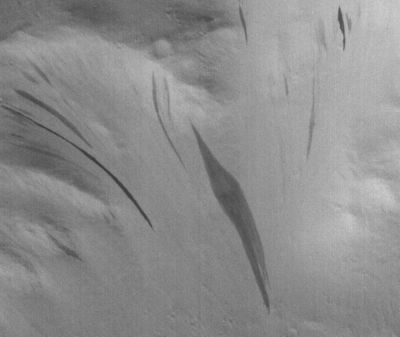
Many places on Mars show dark slope streaks on steep slopes, such as impact crater walls. It seems that the youngest streaks are dark and they become lighter with age. Often they begin as a small narrow spot then widen and extend downhill for hundreds of meters. Several ideas have been advanced to explain the streaks. The streaks appear in areas covered with dust. Much of the Martian surface is covered with dust because at more or less regular intervals dust settles out of the atmosphere covering everything. We know a lot about this dust because the solar panels of Mars rovers get covered with dust. The power of the Rovers has been saved many times by dust devils that have cleared the panels and boosted their power.[39] It is most generally accepted that the streaks represent avalanches of dust. Streaks appear in areas covered with dust. When a thin layer of dust is removed, the underlying surface appears dark. Much of the Martian surface is covered with dust. Dust storms are frequent, especially when the spring season begins in the southern hemisphere. At that time, Mars is 40% closer to the sun. Also, every few years, the entire planet is engulfed in a global dust storm. When NASA's Mariner 9 craft arrived there, nothing could be seen through the dust storm.[40][41] Other global dust storms have also been observed, since that time, including a major one in 2018.
Research, published in 2012 in Icarus, found that some dark streaks were initiated by airblasts from meteorites traveling at supersonic speeds. The team of scientists was led by Kaylan Burleigh, an undergraduate at the University of Arizona. After counting some 65,000 dark streaks around the impact site of a group of 5 new craters, the team discovered patterns. The number of streaks was greatest closer to the impact site. So, the impact somehow probably caused the streaks. Also, the distribution of the streaks formed a pattern with two wings extending from the impact site. The curved wings resembled scimitars, curved knives. This pattern suggests that an interaction of airblasts from the group of meteorites shook dust loose enough to start dust avalanches that formed the many dark streaks. At first it was thought that the shaking of the ground from the impact caused the dust avalanches, but if that was the case the dark streaks would have been arranged symmetrically around the impacts, rather than being concentrated into curved shapes.[42] [43] Dark streaks can be seen in some of the images below and to the left.
Young and old dark streaks, as seen by HiRISE under HiWish program
Dust and dust devil tracks
Dunes and dust devil tracks in the center of Milankovic Crater Dust devils are like tiny tornados, the remove bright dust.
Large portions of the Martian surface are blanketed with bright reddish-brown dust. The dust particles are typically less than 40 micrometres in size and are composed of iron oxide minerals (rust).[44] Data from the Thermal Emission Spectrometer (TES) on the Mars Global Surveyor spacecraft has allowed planetary scientists to estimate the amount of dust cover for broad swaths of the planet.[45] In general, the Diacria quadrangle is extremely dusty, particularly in Arcadia Planitia and the region around the flank of Alba Mons and the Olympus Mons aureole in the southeastern portion of the quadrangle. A few large patches of relatively low dust cover occur in Amazonis Planitia and in the northwest corner of the quadrangle.[46]
Many areas on Mars, including the Diacria quadrangle, experience the passage of giant dust devils. When a dust devil goes by it blows away the coating of dust and exposes the underlying dark surface. Dust devils have been seen from the ground and high overhead from orbit. They have frequently cleaned the dust off of the solar panels of the two Rovers on Mars, thereby greatly extending their lives.[47] The twin Rovers were designed to last for 3 months, instead they both lasted more than six years. The pattern of the tracks have been shown to change every few months.[48] [49]
Depressions in Milankovic Crater
The triangular depressions visible in Milankovic Crater contain water ice in the straight wall that faces the pole, according to a new study.[50] This discovery was hailed as a big deal because it means pure water may be easily acquired for future cities on Mars.[51] Eight sites were found with Milankovic Crater being the only one in the northern hemisphere. This discovery is important because the ice lies under only a meter or two of cover. Research was conducted with instruments on board the Mars Reconnaissance Orbiter (MRO).[52] [53] [54] [55] [56]
The following images are ones referred to in this study of subsurface ice sheets.[57]
Gullies
Martian gullies are small, incised networks of narrow channels and their associated downslope sediment deposits. They are named for their resemblance to terrestrial gullies. First discovered on images from Mars Global Surveyor, they occur on steep slopes, especially on the walls of craters. Usually, each gully has an alcove at its head, a fan-shaped apron at its base, and a single thread of carved channel linking the two, giving the whole gully an hourglass shape.[58] They are believed to be relatively young because they display few, if any, craters. At first, many researchers believed that the process that cut the gullies involved liquid water. However, many scientists today believe that gullies that are being formed today are from chunks of dry ice moving down slopes.[59] In the past, water may have been involved though. The pictures below show examples of gullies in Diacria quadrangle.
Close-up of gullies, as seen by HiRISE under HiWish program. The streamlined shapes were once thought to be caused by running water.
Channels
There is abundant evidence that water once flowed in river valleys on Mars.[60][61] Images of curved channels have been seen in images from Mars spacecraft dating back to the early seventies with the Mariner 9 orbiter.[62][63] [64] [65] Indeed, a study published in June 2017, calculated that the volume of water needed to carve all the channels on Mars was even larger than the proposed ocean that the planet may have had. Water was probably recycled many times from the ocean to rainfall around Mars.[66][67]
Channel network, as seen by HiRISE under HiWish program
Inverted Relief
Inverted relief, inverted topography, or topographic inversion refers to landscape features that have reversed their elevation relative to other features. It most often occurs when low areas of a landscape become filled with lava or sediment that hardens into material that is more resistant to erosion than the material that surrounds it. Differential erosion then removes the less resistant surrounding material, leaving behind the younger resistant material, which may then appear as a ridge where previously there was a valley. Terms such as "inverted valley" or "inverted channel" are used to describe such features.[68] Inverted relief has been observed on Earth and in many locations on Mars.[69]
Inverted stream channels on crater slope, as seen by HiRISE under HiWish program
Brain terrain
Brain terrain is common in many places on Mars. It is formed when ice sublimates along cracks. The ridges of brain terrain may contain a core of ice. Shadow measurements from HiRISE indicate the ridges are 4-5 meters high.[70]
Close view of brain terrain, as seen by HiRISE under HiWish program
Other scenes in Diacria quadrangle
See also
- Alba Patera
- Dark slope streaks
- Dust devils
- High Resolution Imaging Science Experiment (HiRISE)
- Mariner 9
- Mars Global Surveyor
- Martian gullies
- Martian features that are signs of water ice
- Olympus Mons
- Oceans on Mars
- Opportunity
- Periodic climate changes on Mars
- Phoenix Mars Mission
- Rivers on Mars
- Spirit
- Sublimation
- Sublimation landscapes on Mars
- Water
References
- ↑ Davies, M.E.; Batson, R.M.; Wu, S.S.C. "Geodesy and Cartography" in Kieffer, H.H.; Jakosky, B.M.; Snyder, C.W.; Matthews, M.S., Eds. Mars. University of Arizona Press: Tucson, 1992.
- ↑ USGS Gazetteer of Planetary Nomenclature. Mars. http://planetarynames.wr.usgs.gov/.
- ↑ Smith, P. et al. H2O at the Phoenix Landing Site. 2009. Science:325. p58-61
- ↑ Smith, P., et al. 2009. H2 O at the Phoenix Landing Site. Science: 325, 58-61.
- ↑ https://www.nasa.gov/mission_pages/phoenix/news/phoenix-20080530.html
- ↑ The Dirt on Mars Lander Soil Findings
- ↑ http://www.diss.fu-berlin.de/diss/servlets/MCRFileNodeServlet/FUDISS_derivate_000000003198/16_ColdClimateLandforms-13-utopia.pdf?hosts=
- ↑ Kostama, V.-P., M. Kreslavsky, Head, J. 2006. Recent high-latitude icy mantle in the northern plains of Mars: Characteristics and ages of emplacement. Geophys. Res. Lett. 33 (L11201). doi:10.1029/2006GL025946.K
- ↑ Malin, M., Edgett, K. 2001. Mars Global Surveyor Mars Orbiter Camera: Interplanetary cruise through primary mission. J. Geophys. Res. 106 (E10), 23429–23540.
- ↑ Milliken, R., et al. 2003. Viscous flow features on the surface of Mars: Observations from high-resolution Mars Orbiter Camera (MOC) images. J. Geophys. Res. 108 (E6). doi:10.1029/2002JE002005.
- ↑ Mangold, N. 2005. High latitude patterned grounds on Mars: Classification, distribution and climatic control. Icarus 174, 336–359.
- ↑ Kreslavsky, M., Head, J. 2000. Kilometer-scale roughness on Mars: Results from MOLA data analysis. J. Geophys. Res. 105 (E11), 26695–26712.
- ↑ Seibert, N., J. Kargel. 2001. Small-scale martian polygonal terrain: Implications for liquid surface water. Geophys. Res. Lett. 28 (5), 899–902.
- ↑ Hecht, M. 2002. Metastability of water on Mars. Icarus 156, 373–386
- ↑ Mustard, J., et al. 2001. Evidence for recent climate change on Mars from the identification of youthful near-surface ground ice. Nature 412 (6845), 411–414.
- ↑ Kreslavsky, M.A., Head, J.W., 2002. High-latitude Recent Surface Mantle on Mars: New Results from MOLA and MOC. European Geophysical Society XXVII, Nice.
- ↑ Head, J.W., Mustard, J.F., Kreslavsky, M.A., Milliken, R.E., Marchant, D.R., 2003. Recent ice ages on Mars. Nature 426 (6968), 797–802.
- ↑ LA NASA/Jet Propulsion Laboratory |date=December 18, 2003 | title= Mars May Be Emerging From An Ice Age |work= ScienceDaily |accessdate=February 19, 2009 |url= https://www.sciencedaily.com/releases/2003/12/031218075443.htm }}
- ↑ Carr, M.H. The Surface of Mars; Cambridge University Press: New York, 2006.
- ↑ University of Arizona HiRISE Website. http://hirise.lpl.arizona.edu/PSP_010345_2150.
- ↑ Plescia, J.B. "Acheron Fossae, Mars: Evidence of Fluvial Activity and Mass Flow;" Lunar and Planetary Science Conference XXXVII, 2006.
- ↑ Cattermole P. Mars: the Mystery Unfolds; Oxford University Press: New York, 2001.
- ↑ Tanaka, K.L.; Scott, D.H.; Greely, R. "Global Stratigraphy" in Kieffer, H.H.; Jakosky, B.M.; Snyder, C.W.; Matthews, M.S., Eds. Mars; University of Arizona Press: Tucson, 1992.
- ↑ https://www.ncbi.nlm.nih.gov/pmc/articles/PMC4872529/
- ↑ Carr, M. & J. Head. 2010 Geologic history of Mars. Earth and Planetary Science Letters. 294. 185-203.
- ↑ Clifford, S. M.; Parker, T. J. (2001). "The Evolution of the Martian Hydrosphere: Implications for the Fate of a Primordial Ocean and the Current State of the Northern Plains". Icarus. 154 (1): 40–79. Bibcode:2001Icar..154...40C. doi:10.1006/icar.2001.6671
- ↑ Baker, V. R.; Strom, R. G.; Gulick, V. C.; Kargel, J. S.; Komatsu, G.; Kale, V. S. (1991). "Ancient oceans, ice sheets and the hydrological cycle on Mars". Nature. 352 (6336): 589–594.
- ↑ Lucchitta, B. et al. 1986. Sedimentary deposits in the northern lowland plains, Mars. Proc. Lunar planet. Conf. 17th, part 1, j. Geophys. Res., 91, suppl., E166-E174.</refMars’ atmospheric history derived from upper-atmosphere measurements of 38Ar/36Ar. Science 355 (6332): 1408-1410; doi: 10.1126/science.aai7721
- ↑ http://www.sci-news.com/space/maven-martian-atmosphere-lost-space-04750.html
- ↑ http://astrobiology.com/2016/05/ancient-tsunami-evidence-on-mars-reveals-life-potential.html
- ↑ Rodriguez, J.; et al. 2016. "Tsunami waves extensively resurfaced the shorelines of an early Martian ocean. :" (PDF). Scientific Reports / 47th Lunar and Planetary Science Conference. 6:
- ↑ Head, J., et al. 2018. TWO OCEANS ON MARS?: HISTORY, PROBLEMS AND PROSPECTS. 49th Lunar and Planetary Science Conference 2018 (LPI Contrib. No. 2083). 2194.pdf
- ↑ http://www.uahirise.org/epo/nuggets/expanded-secondary.pdf
- ↑ Viola, D., et al. 2014. EXPANDED CRATERS IN ARCADIA PLANITIA: EVIDENCE FOR >20 MYR OLD SUBSURFACE ICE. Eighth International Conference on Mars (2014). 1022pdf.
- ↑ Byrne, S. et al. 2009. Distribution of Mid-Latitude Ground Ice on Mars from New Impact Craters: 329.1674-1676
- ↑ http://www.space.com/scienceastronomy/090924-mars-crater-ice.html
- ↑ http://news.aol.com/article/nasa-spacecraft-sees-ice-on-mars-exposed/686020
- ↑ http://nasa.gov/mission/MRO/news/mro20090924.html
- ↑ https://www.sciencedaily.com/releases/2009/02/090217101110.htm
- ↑ ISBN|0-517-00192-6
- ↑ {{cite book|author=Hugh H. Kieffer|title=Mars|url=https://books.google.com/books?id=NoDvAAAAMAAJ%7Caccessdate=7 March 2011|year=1992|publisher=University of Arizona Press
- ↑ Kaylan J. Burleigh, Henry J. Melosh, Livio L. Tornabene, Boris Ivanov, Alfred S. McEwen, Ingrid J. Daubar. Impact air blast triggers dust avalanches on Mars. Icarus, 2012; 217 (1): 194
- ↑ http://redplanet.asu.edu/
- ↑ Barlow, N. Mars: An Introduction to Its Interior, Surface, and Atmosphere; Cambridge University Press: New York, 2008.
- ↑ Ruff, S.W.; Christensen, P.R. 2002. "Bright and Dark Regions on Mars: Particle Size and Mineralogical Characteristics Based on Thermal Emission Spectrometer Data," Journal of Geophysical Research, 107, E12, 5127.
- ↑ TES Dust Cover Index. http://www.mars.asu.edu/~ruff/DCI/dci.html.
- ↑ http://marsrovers.jpl.nasa.gov/gallery/press/spirit/20070412a.html
- ↑ url=http://mars.jpl.nasa.gov/spotlight/KenEdgett.html
- ↑ http://mars.jpl.nasa.gov/spotlight/kenEdgett.html
- ↑ https://www.uahirise.org/ESP_071573_2350
- ↑ Dundas, E., et al. 2018. Exposed subsurface ice sheets in the martian mid-latitudes. Science. 359. 199.
- ↑ Steep Slopes on Mars Reveal Structure of Buried Ice. NASA Press Release. 11 January 2018.
- ↑ Ice cliffs spotted on Mars. Science News. Paul Voosen. 11 January 2018.
- ↑ https://www.slideshare.net/sacani/exposed-subsurface-ice-sheets-in-the-martian-midlatitudes
- ↑ http://spaceref.com/mars/steep-slopes-on-mars-reveal-structure-of-buried-ice.html
- ↑ Colin M. Dundas, et al. Science, 12 January 2018. Vol. 359, Issue 6372, pp. 199-201.
- ↑ Supplementary Materials Exposed subsurface ice sheets in the Martian mid-latitudes Colin M. Dundas, Ali M. Bramson, Lujendra Ojha, James J. Wray, Michael T. Mellon, Shane Byrne, Alfred S. McEwen, Nathaniel E. Putzig, Donna Viola, Sarah Sutton, Erin Clark, John W. Holt
- ↑ Malin, M., Edgett, K. 2000. Evidence for recent groundwater seepage and surface runoff on Mars. Science 288, 2330–2335.
- ↑ Harrington |first=J.D. |last2=Webster |first2=Guy |title=RELEASE 14-191 – NASA Spacecraft Observes Further Evidence of Dry Ice Gullies on Mars |url=http://www.nasa.gov/press/2014/july/nasa-spacecraft-observes-further-evidence-of-dry-ice-gullies-on-mars |date=July 10, 2014 |work=NASA |accessdate=July 10, 2014
- ↑ Baker, V., et al. 2015. Fluvial geomorphology on Earth-like planetary surfaces: a review. Geomorphology. 245, 149–182.
- ↑ Carr, M. 1996. in Water on Mars. Oxford Univ. Press.
- ↑ Baker, V. 1982. The Channels of Mars. Univ. of Tex. Press, Austin, TX
- ↑ Baker, V., R. Strom, R., V. Gulick, J. Kargel, G. Komatsu, V. Kale. 1991. Ancient oceans, ice sheets and the hydrological cycle on Mars. Nature 352, 589–594.
- ↑ Carr, M. 1979. Formation of Martian flood features by release of water from confined aquifers. J. Geophys. Res. 84, 2995–300.
- ↑ Komar, P. 1979. Comparisons of the hydraulics of water flows in Martian outflow channels with flows of similar scale on Earth. Icarus 37, 156–181.
- ↑ http://spaceref.com/mars/how-much-water-was-needed-to-carve-valleys-on-mars.html
- ↑ Luo, W., et al. 2017. New Martian valley network volume estimate consistent with ancient ocean and warm and wet climate. Nature Communications 8. Article number: 15766 (2017). doi:10.1038/ncomms15766
- ↑ Pain, C.F., and C.D. Ollier, 1995, Inversion of relief - a component of landscape evolution. Geomorphology. 12(2):151-165.
- ↑ Pain, C.F., J.D.A. Clarke, and M. Thomas, 2007, Inversion of relief on Mars. Icarus. 190(2):478–491.
- ↑ Levy, J., J. Head, D. Marchant. 2009. Concentric crater fill in Utopia Planitia: History and interaction between glacial “brain terrain” and periglacial mantle processes. Icarus 202, 462–476.
External links
- High resolution video by Seán Doran of a flyover of crater Domoni (51.7° N, 125.6° W)
- Chris McKay: Results of the Phoenix Mission to Mars and Analog Sites on Earth
